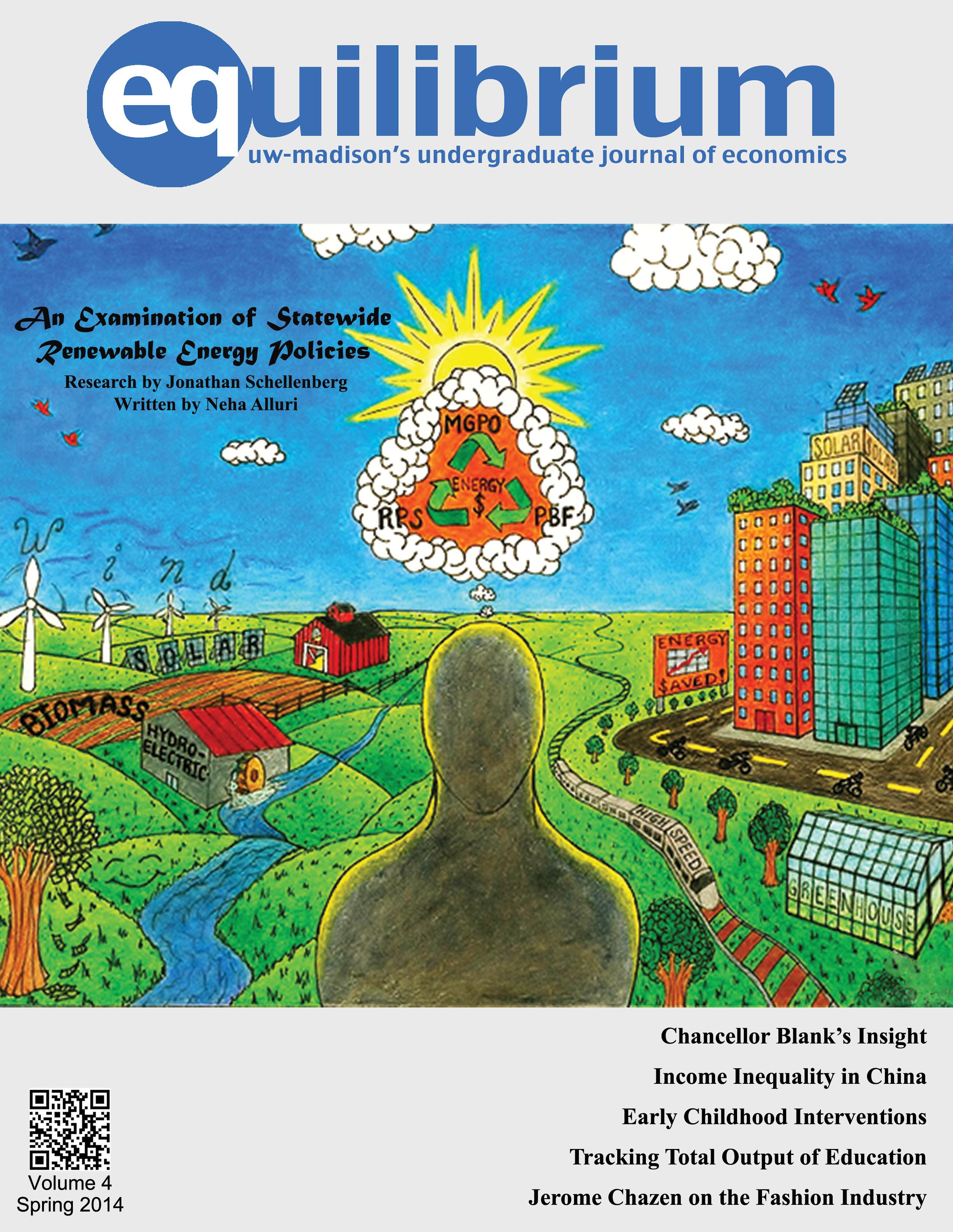
Dear Reader,
I think we speak for the whole Equilibrium staff when we acknowledge how proud we are of being a part of this journal, and how excited we are to share it with you. Now in its fourth edition, Equilibrium has provided a unique medium for our top students, faculty, and alumni to share their remarkable research and accomplishments. All of the contents of this publication have been produced by our fantastic undergraduate staff of writers, editors, and artists, and we would like to say a special thank you to the professionals featured in this year’s edition. Without them, the journal would not be nearly as comprehensive and engaging.
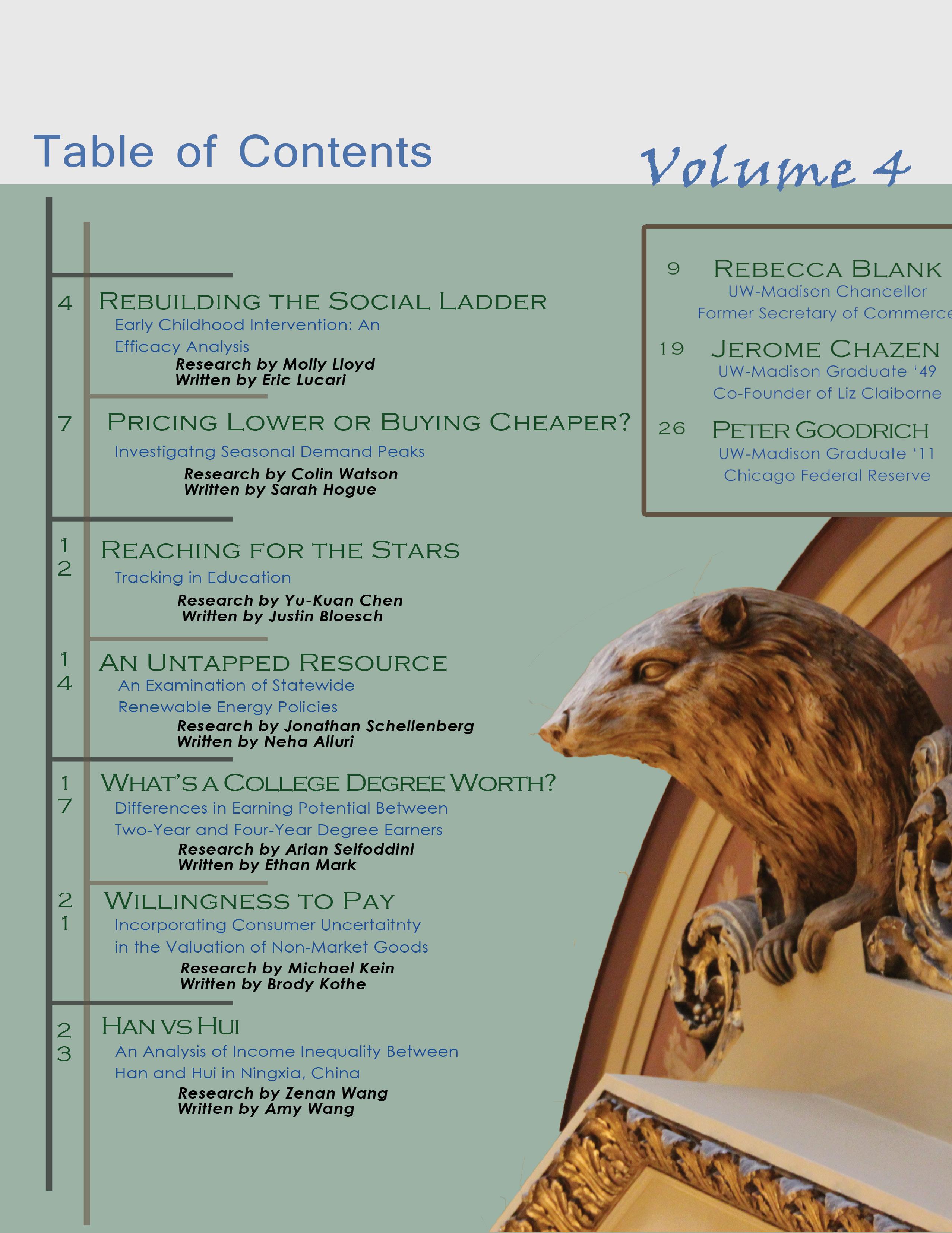
Though it is still young in its presence on campus, we strongly believe that Equilibrium has the potential to contribute meaningfully to the Economics department and discussions across the university as a whole. We hope that this publication serves to motivate the investigation of economics, both as a field of study and a career, and to share the discovery of new knowledge from our distinguished contributors to you. We also hope that this publication provides insight on skills acquired by the students who are successful in this discipline, highlighting the future leaders who will bring those skills and talents into their careers and communities.
Previous editions of Equilibrium have set the bar very high. We hope that volume 4 meets this standard, and we are optimistic that future editions will be even better. Building on the successes of the previous volume, we decided to retain many stylistic components in order to develop our own distinctive Equilibrium brand. If you read last year’s edition, we hope you recognize it.
We would like to thank our readers for their support of our staff and publication. We strive to produce a journal that is both visually captivating and intellectually stimulating by complementing the impressive economic content with stunning artistry. We hope you enjoy it!
Special Thanks
Chancellor Rebecca Blank
Dean John Karl Scholz
Professor Ananth Seshadri
Professor Ken West
Jerome A. Chazen
The Economics Department Staff
The Economics Students Association
The Many Other Contributors and Supporters of Equilibrium
Sincerely, Geoffrey Curley and Justin Bloesch Editors-in-Chief
Contact Equilibrium Staff
William H. Sewell Social Sciences Room 7238 1180 Observatory Drive Madison, WI 53706-1393

Rebuilding the Social Ladder
Early Childhood Intervention: An
Efficacy Analysis
Research by Molly Lloyd Written by Eric Lucari Photography by Taylor McGrath
In his 2013 State of the Union address, President Obama called the absence of social mobility the “defining challenge of our time.” While economic research on social mobility is not yet conclusive, there is widespread perception that getting ahead is simply not as easy as it once was.
There are many reasons to worry that social mobility may be declining. Between rising college tuition, a hollowing out labor market for middle-income
Chicago. Heckman has emphasized the importance of early childhood intervention programs (ECIs) as the key to turning around the growing skills gap between high- and low-income kids. According to research by geneticists and neuroscientists, a majority of cognitive ability is solidified by age ten. When interviewed on his research into sustained outcomes correlated with
city of parenting resources. Of the many ECIs that have tried and failed, there also is not an effective way of measuring where they succeeded and why. As the US continues to lag behind other
“The real scarcity isn’t money. The real scarcity, at least when it comes to this matter of forming skills, is parenting. And that explains a lot of paradoxes.”
workers, and a scarcity of work for those without a college degree, it certainly appears that upward mobility is on its way down. Perhaps most strikingly, the achievement gap between the wealthiest and poorest students is now twice as large as the black-white achievement gap.
Social science researches have dedicated great effort in determining the causes of this growing inequality, and one factor stands out: early childhood development. Among these researchers is James Heckman, a Nobel Prize winning economist at the University of
ECIs, Heckman said:
“The real scarcity isn’t money. The real scarcity, at least when it comes to this matter of forming skills, is parenting. And that explains a lot of paradoxes. You have kids growing up in some of the worst circumstances financially, living in some of the worst ghettos, and they succeed. They succeed because an adult figure, typically a mother, maybe a grandmother, nourishes the kid, supports the kid, protects the kid, encourages the kid to succeed. It’s as if the environment never happened.”
A problem, which Heckman has acknowledged, is that we have not found a systematic way to reallocate the scar-
countries in education outcomes, there has never been a better time to reevaluate the environment we provide to disadvantaged children, and gain a deeper understanding of the programs we design.
Last year, University of Wisconsin-Madison Economics student, Molly Lloyd, conducted a review of past ECIs and their corresponding outcomes for disadvantaged children. Lloyd undertook the study in order to create a means of comparing the effectiveness of these programs on bridging the socioeconomic achievement gap. Her study reaffirmed that ECIs definitely do improve
life outcomes, equality levels, and intergenerational mobility for children from low-income families.
Developmental neuroscience shows that infant brains have greater plasticity in the earliest period of life and that is the critical time to intervene. Molly also makes the argument that the key to sustaining the positive outcomes of ECIs is continued investment at later stages of education to solidify the gains in earlier years. The concept of fade out effects is one that has constantly plagued the success of ECI programs. Often the children initially benefit from the services of a program, but revert back to past levels of achievement once they have left the program for the next stage of schooling. The goal of Lloyd’s thesis is to create a more usable reference for policy makers when discussing a universal ECI program. She hopes that her efforts will help mitigate the harmful effects that cognitive delays can have on a child’s development, while also minimizing fade out effects.
Lloyd challenges the notion that
cost-benefit analysis should be the basis of evaluation for ECI programs. She argues that limited data positively skews ROI figures, and definitions of benefits and costs are too variable across calculations. Lastly, because historical studies have not included standard error calculations, they are irrelevant for comparative analysis.
Poverty.” The many variables that differ at the community level make this a difficult program to evaluate, so there are no good metrics that detail the aggregate success of the program. Studies by organizations such as the U.S. Health Department have shown that the program fails at creating sustained outcomes, with most improvements fading out after the third grade. In recent years, there have been quality control initiatives that have raised the required credentials for head start teachers, with the hope that this will increase positive outcomes for disadvantaged children.
Historical Review of ECI Programs
Lloyd’s data set included studies from seven ECI programs, the most well known being the Carolina Abecedarian program, Lyndon B. Johnson’s Head Start Program, the Perry Preschool, and the more recent Public Pre-School model. The three programs varied on dimensions of scale and emphasis, but Lloyd dissects them in a way that shows how they could potentially complement each other.
Clearly the most expensive ECI ever undertaken, costing roughly $36,000 per child, the Carolina Abecedarian project was a year round program that followed infants up until age five. This program emphasized the necessity of multistage outcomes to guarantee improved lifetime outcomes and provided participants with a home schoolteacher to aid in education and social services. Although college graduation rates of participants improved from 6% to 23% (with a p = 0.03), there was no significant difference in earnings between the control group and the treatment group.
President Lyndon B. Johnson created the most well known program, Head Start, in 1965 as part of his “War on
The Perry Preschool experiment is the best study we have on ECI programs. Participants were tracked until age 40 to measure lifetime outcomes. The experiment was conducted from 1962-67 with 123 children from disadvantaged African American families in Michigan. It required teachers to teach small groups of six children and make weekly home visits to engage parents. In the categories of income, home ownership, employment, education level, and criminal record, all participants had improved outcomes. Adjusted for calculation error, this program yielded an incredible 7-10% annual rate of return.
A program that has been making headlines lately is free public preschool, specifically in states like Oklahoma that have participation rates as high as 70%. Teachers are required to have a college degree and proper certifications, and class sizes must be no more than 10:1 ratios. Studies show that this program has statistically significant positive outcomes for language skills and achievement scores, but no long-term studies were conducted on life outcomes.
Choosing the Right ECI Policy

4 5
Equilibrium Volume 4 Rebuilding the Social Ladder
After organizing the different outcomes and variables of the programs, Lloyd identified a few key points for developing a universal ECI policy.
As expected, the most routine problem of these programs is the fade out effect, meaning the neutralization of improved education outcomes when extrapolated to consider income, employment, and other later in life measures of achievement. However, Lloyd notes that some of these fade out affects could be attributed to prejudicial hiring practices and limited opportunities for disadvantaged minority groups.
Lloyd suggests a hybrid of some of these programs to fully embrace the positive effects of multi-stage investment in children’s
Pricing Lower or Buying Cheaper?
During the forty days of Lent from February to April, some Christians abstain from meat consumption and consume more fish instead. This leads to a seasonal peak in demand for canned tuna. Yet alongside this exogenous increase in demand, there occurs a decline in the average retail price paid for canned tuna. Other product categories such as cheese, snack crackers, and beer experience similar price declines during holiday periods when consumers are likely to demand them most. This example shows that the retail price paid by consumers of a product category may be lowest during periods of peak demand. In his thesis entitled “Pricing Lower or Buying Cheaper?” recent graduate of the University of Wisconsin-Madison Colin Watson seeks to explain this phenomenon by examining two competing theories: the supply side and demand side decisions made by consumers and groceries stores during the holiday seasons.
lost from the reduction of the price of turkey.
The loss leader strategy can be contrasted with a demand side strategy. Consumers often demand lower quality products during peak demand periods, which leads to a decrease in the average price paid for the good. An example of the demand side theory is the contribution by party-goers of a generic brand of chips to a holiday potluck. The purchase of a cheaper brand of chips may be outside their normal behavior of purchasing an expensive brand for personal consumption throughout the year. The shift to less expensive goods during the holiday season drives down the average price paid for the good, even though the individual prices of those goods have not changed.
 Written by Sarah Hogue Artwork by Taylor McGrath
Written by Sarah Hogue Artwork by Taylor McGrath
education. First, social service intervention is key to helping parents break the poverty cycle and provide adequate support for their children’s education. Echoing Heckman, there is a scarcity of quality environments for the underachievers. Secondly the education system established by the Perry experiment generated healthy returns of 7-10% for earnings and costs savings among participants, thus demonstrating individualized attention is one way to improve cognitive development. Lastly, home visitation as seen in several of the programs was essential to maintaining a family environment that cemented the positive effects of educational initiatives. Ultimately, it is the parents who will have the most impact on their children’s achievement levels as they continue to high school and college.
Improved ECIs have the potential to be the equalizer in the fight against the achievement and income gaps. High participation in just preschool has been correlated with increases in workforce participation, future income, and gender equality. If something does not change, there may be no more options for those not educated to participate in the information economy of the US.


One reason for the decline in average prices during seasonal demand peaks is the supply side theory, or loss leader explanation. The loss leader strategy describes how stores discount and advertise a few highly demanded products in order to attract customers who will then pay an undiscounted price for other goods. An example of this is the reduction in the price of turkey during Thanksgiving. The profit made from cranberry sauce and other side dishes compensates stores for the profit
Watson examines two studies that used the same data, but reached opposing conclusions. The data came from eight years of sales at Dominick’s, a Chicago supermarket chain. A study conducted in 2003 by Chevalier, Kashyap, and Rossi suggests that price declines during the holiday season can be explained by the loss leader strategy. In contrast, a 2006 study conducted by Nevo and Hatzitasko determined that the price decline is a result of the consumer demand side strategy. Watson uses the same data to compare his conclusions to these two studies. He strives to answer the question of whether retailers price
lower during peak demand periods or if consumers buy cheaper products during this period.
During his preliminary analysis, Watson looks at each price decline during the demand period and decomposes it into reductions in the retail prices of individual products, the choice of consumers to choose other goods, and the decision of consumers to buy when goods are discounted. Watson concludes that consumers pay the least per unit of product at the same time they are buying the most units. This is a result of two patterns. As suggested by Nevo and Hatzitasko’s study, consumers substitute to lower-quality products during peak demand periods. Retail price reductions on individual products contribute to the category average price declines, as the study conducted by Chevalier, Kashyap, and Rossi indicated. After further analysis of the effect of discounts on demand, Watson finds that the loss leader model explains the why the average price paid for goods may decline while price remained the same.
Watson uses regression to examine the data, but unlike the 2003 and 2006 studies previously mentioned, he also looks at how sales fluctuated around the holidays. This new insight into the effect of consumer time substitution is important to Watson’s conclusions because of its relation to the demand side explanation and information about
6 7
Rebuilding the Social Ladder Equilibrium Volume 4
Research by Colin Watson
Equilibrium Volume 4 Pricing Lower or Buying Cheaper?
cyclical fluctuations in price. He examines seasonal peaks in sales volume during Lent for canned tuna, Thanksgiving and Christmas for cheese and snack crackers, and the purchase of beer during summer holidays such as Memorial Day, the Fourth of July, and Labor Day. Each event is associated with a tradition of consumption of the specified goods around that time. Therefore, there is reason to theorize that an increase in sales volume during these occasions will reflect the increase in the level of demand.
Further analysis of Dominick’s sales allows Watson to determine the effect that the implementation of discounts by grocery stores has on consumption. Dominick’s, as a chain, has the ability to discount in many stores, which is generally uniform across all stores. Thus, Dominick’s can set many different prices each week, with the consumer adjusting preferences accordingly. Consumers act with discount-correlated substitution, which increases the price impact of retailer discounts. This type of substitution can also affect the average price paid for a category of products. In most cases of the categories of goods analyzed, the discount-correlated substitution had only a small effect on the price change. However, in the case of canned tuna, this substitution had a large impact. Watson concludes that a price decline during a high demand for tuna is not just due to a reduction in prices offered or customer substitution to discounted products. Instead, consumers arrange their purchases of products in a way that takes advantage of the lowest prices offered by the grocery store. Discounts and discounted-correlated substitution play an equally large role as a shift to a generic version of the product during demand peaks.
To take a closer look at these assertions, canned tuna was analyzed more closely. Canned tuna was shown to exemplify falling prices in seasonal demand peaks, as proven by

Watson’s preliminary analysis. Canned tuna was shown to have a 50 percent increase in volume and a 23 percent drop in price during a four-week shopping period around Lent. A price effect, the measure of how the change in a price of a commodity changes the consumption of the good, was found in the data. A composition effect, the measure of an effect in the change of market share, was also found to be an important factor in the decrease of the price of tuna. However, much of the price reduction can be attributed to an increase in consumer utilization of weekly discounts.
Watson examines six different brands of tuna and found Chicken of the Sea was purchased at a price 40% lower during Lent as compared to the rest of the year. Chicken of the Sea exhibited a much larger price decrease than any of the other brands analyzed. This decrease in price was not due to a decrease in its simple average price, but rather caused by an increase in the importance of weekly discounts. Possibly because of the large price reduction, Chicken of the Sea nearly triples its market share during Lent.
The data shows that Chicken of the Sea products are consistently priced lower than other products throughout the year. The patterns in other product categories further cement the idea that consistently lower priced goods tend to increase their market shares, and products with increasing market shares tend to reduce their prices.
In the examination of tuna, the price reductions were achieved by the retailer’s use of weekly discounts and the consumer’s substitution of products that corresponded. This case of discount-correlated substitution had a large impact on the price decline of tuna, showing the impact of discounts implemented by retailers.
Through the unique analysis of raw data, Watson draws his own conclusions and compares them to those of other studies. He concludes that the retailer reduced prices on low-quality products in categories where it anticipated higher demand. The price reduction caused consumer substitution towards the products with the lower prices, creating a peak demand price decline that is a combination of product prices and shifts to lower-quality products. In most of the categories of products analyzed, both of these factors played an important role. Overall, Watson determines that the patterns found in peak demand price declines follow the loss leader explanation.
It is important to see this examination of supply and demand leads to intriguing conclusions. Simplified economic theory says that demand increases with a decrease in price and supply decreases with a decrease in price. However, Watson’s study shows us that further examination of every day topics may lead to other interesting conclusions about how complex economic theory really is.
So the question to ask yourself next Labor Day: will you bring Spotted Cow to the barbeque or Miller Lite?
The Engine of Innovation
Equilibrium sat down with Rebecca Blank, Chancellor at the University of Wisconsin-Madison, to talk about her experiences working in government and her goals as the leader of our prestigous university. Blank worked on the Council of Economic Advisors during the Clinton Administration in 1996, and she was also Acting Secretary of Commerce before entering her position at the University of Wisconsin. We are delighted to share with you her experiences and thoughts on how to stimulate growth in today’s economy.
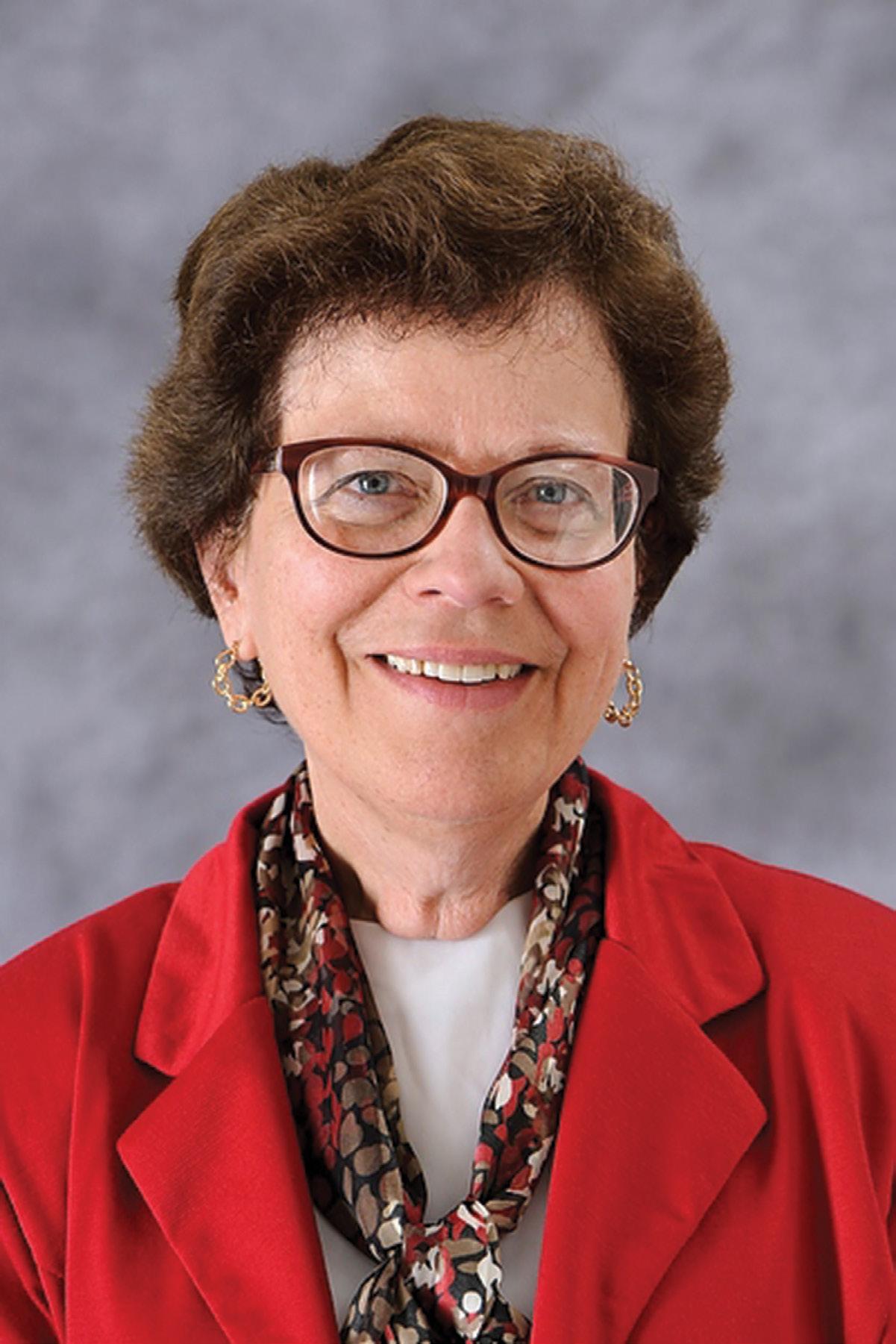
EQ: Why did you choose to study economics as an undergraduate student at the University of Minnesota?

Blank: In my second semester, I took an intro macroeconomics class taught by Walter Heller who had been quite a famous economist in the 60’s and 70’s. He was chair of the council of economic advisors under President John Kennedy and he was a superb teacher. I gained a sense that the field of Economics is something that is really fun and interesting in some ways but also has some very real applications to a whole set of issues out there in the world that I care a lot about. After taking some economics classes, I really liked the fact that they used both my mathematical abilities as well as my reasoning abilities which wasn’t true of many other classes in the social sciences. So I ended up as an economics major out of an interest in the theory of economics and the ways in which you can use it to understand and explore the world.
EQ: What do you think students can learn from studying economics that they can’t from other areas of study?
Blank: Economics involves a set of pretty sophisticated theory and you have to be able to follow a line of reasoning both numerical and logical. It’s not that you can’t learn these skills in other disciplines, but you have to learn that in economics to do well in the classes, and I think that’s important. I think economics provides you with a set of tools, and not only is it intellectually interesting but you can
8 9 The Engine of Innovation Equilibrium Volume 4
Pricing Lower or Buying Cheaper? Equilibrium Volume 4
use it in all sorts of ways, and so people with economic degrees have a great set of jobs open to them. There are other people at the university that can get those jobs also, but with the economics degree stamps you as someone who knows a set of things and has a set of interests that the business world appreciates and the policy world appreciates, and that’s very useful to come out of college with.
EQ: How does your economics discipline influence your decisions as a chancellor?
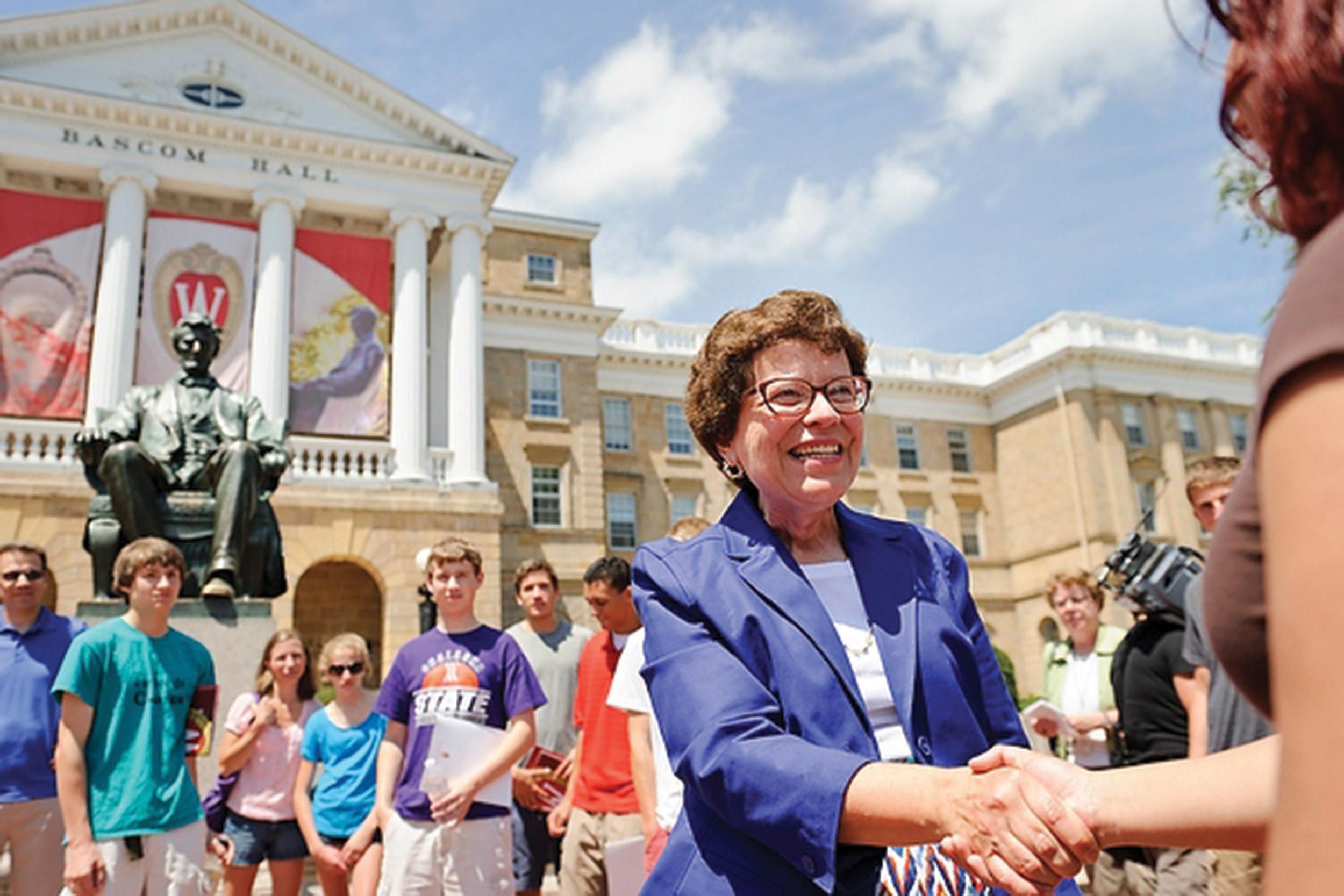
Blank: I wouldn’t just say this about my job as a chancellor, but the previous jobs that I had as the Dean of the University of Michigan or in senior positions at the Department of Commerce. It really helps in these positions to think clearly about these issues even if they aren’t economics issues. Economics has a model and it tells you to think about the world in terms of models. Now, all models have problems. They are always too simple, but they give you a starting point. What I find for myself, and I think this is true for the other economists who eventually become presidents or chancellors of universities, is that there’s a way of looking at the world and asking questions about issues that I think economics prepares you particularly well for. This means that I don’t have problems understanding budgets and I don’t have problems understanding the numerical aspects of this job, which is very important. A lot of people come into this job from other backgrounds and I think they have to learn more about the numbers side. The value of knowing what you can learn through analysis and numbers, that’s an art which you learn over time but economics puts you in a good position to be further down the road on that.
EQ: How have your previous work experiences helped you as a chancellor?
Blank: On the one hand, and this is a management issue and not necessarily economics related, I spent two and a half years as the Deputy Secretary of the Department of Commerce which is the Chief Operating Officer of a department of roughly 45,000 employees and about a $10 billion budget. It involves a very diverse set of agencies inside of commerce. We had everything from the national weather service, to the patent and trademark office, to the census bureau, to the international trade administration. So, I learned an enormous amount about managing a large organization which was an incredibly valuable experience coming here to manage another large organization – the University of Wisconsin. Managing in a public sector entity with a lot of regulations on you and a lot of public exposure, that’s not all that different here in Wisconsin as it was in Washington D.C. On the substantive side, particularly during my time
as Acting Secretary, I spent a lot of time working with various groups as well as travelling around the country talking about competitiveness in the United States and what were the important things for the U.S. to be paying attention to. Among the issues that I talked about was the need for a skilled workforce, and what we needed to do to make sure that happened. That’s very closely related to the issues I work on everyday as Chancellor.
Secondly, I spent a lot of time talking about innovation and the need for the U.S. to be the innovation economy because that is what will keep the U.S. industry on the front-edge of the global economy. I would visit places where you could see examples of very high-tech manufacturing that utilized a lot of new innovative techniques to be competitive as a U.S.-based manufacturing company. I had a lot of conversations with people about innovation and about ways in which businesses could interact with institutions like universities, about tech transfer efforts on the part of universities or communities to increase the amount of new start-ups and entrepreneurship, and other substantive issues that are also incredibly relevant to this job. I think for a university to be doing what it needs to do, particularly a public university in the state of Wisconsin, is to be actively engaged in the development efforts of this state. Being the engine of innovation, the “ideas factory” is what I’ve referred to it as, and developing partnerships with the private sector around the state to make sure that the ideas generated at this university have a chance to be transferred into the public domain to be used to create new business and new ways of doing things. All of that is deeply important and that is what I was doing at the Department of Commerce, and its one of the things I’m working on here. So there are many ways in which my previous positions correlate to my responsibilities now.
EQ: How do you support innovation within the school or community?
Blank: The first thing you do is you make sure that you hire and retain the best scientists and researchers in the country. We do have some challenges around faculty salaries, which is something that I am working on, but you’ve got to get the right people here. The right people, in turn, bring in great graduate students and they generate dollars by writing successful grants that have both national and international reputations. Secondly, you’ve got to create an atmosphere that allows an open exchange of ideas on important problems. One of the things that Wisconsin has long done very well is have a number of interdisciplinary research centers that bring faculty from across campus together to work on common issues. We have the Nelson Institute which brings together just an enormously wide group of people – biologists, social scientists, chemists, etc. – to work on issues related to the environment. We have the Waisman Center which brings together all sorts of medical, physiological, and educational people to work on issues related to disabilities. There is also the Energy Center as well as the
Wisconsin Institute of Discovery, and these sorts of interdisciplinary centers are just as important as salary and sometimes more important at attracting and retaining your top scientists and faculty because they are the places where people want to hang out. They are places where people get good ideas, where they meet colleagues, and where they generate productive research collaboration. So, to sustain innovation you hire the best people and create opportunities for them to interact together in a way that they enjoy and makes them do even better work. Now that’s not easy to do, but the University here has a long reputation of doing that well and one of my major charges as chancellor is to keep that going.
EQ: Do you have any insight for students on campus considering, or already pursuing, a degree in economics?
Blank: Well, economics is a great major. It’s one where you will learn a lot even if you don’t continue on in economics. You learn something about how to think and how to use numbers, graphs, and reasoning which I think is all very helpful. Also, if you’re interested in it, there is a whole variety of jobs available to students with an undergraduate degree in economics. So, I’m a big fan of the economics major and I’m delighted to know that it’s one of the biggest majors here on campus. But at some level, it doesn’t matter as much what your major is as it does what you do with it. The objective as an undergraduate is to learn as much as you can about things you know little about. Learn more about math, learn more about geology, learn more about biology, and learn more about art and literature. This is a campus that has so much to offer and a major gives you the ability to really think deeply about that field. That type of experience combined with writing, numeracy, and analytical reasoning, which any major can provide, is what will make you both a productive worker and a good citizen to society. What I really hope more than anything else as far as students here at Wisconsin is that they come out of this university and, regardless of where they go, they can look back on their time here say, “I learned something really useful and I’m a better person because of it.”

10 11 The Engine of Innovation The Engine of Innovation Equilibrium Volume 4 Equilibrium Volume 4
Reaching for the Stars
Tracking in Education
Traditionally, tracking students in schools is believed to support star educational outcomes but can also reinforce educational gaps between wealthy and poorer students. What if this tradeoff does not have to exist?
Tracking is a controversial but widely used practice in education. Under a system of tracking, schools separate students by ability, or put them in “tracks.” Proponents of tracking argue that tracking is better for everyone: talented students benefit greatly from being in small, challenging classes with similarly motivated peers, while struggling students are provided with targeted instruction. Critics point out that tracking segregates wealthier and poorer students, furthering the socioeconomic divide in educational attainment. In his essay, “Efficiency of Tracking in Education,” UW-Madison exchange student Yu-Kuan Chen tries to determine under
tributive policies, which increase equality of outcomes, have a long-term, negative impact on economic growth. Simply put, efficiency makes a bigger pie, but equity requires that shares of the pie are evenly distributed. But what if equity and efficiency aligned? Chen explores under what conditions equity and efficiency are in agreement under educational tracking.
Chen begins by describing the first case, where equity and efficiency are at odds. He describes a one-period model in which educational planners decide how to sort students into classes. The planners have two choices: to put
Research by Yu-Kuan Chen Written by Justin Bloesch
educational outcomes. Therefore, in a one-period model with supermodular learning, equity and efficiency are in conflict.
dents learn over time. To do this, we will use the concept of concavity.
being separated off. Therefore, having integrated classrooms in the first stage is both equitable and efficient.

reasonable to suggest that all students benefit from smart peers, but who benefits the most? One case is that high-ability students benefit the most from having smart peers, and that their combined ability and enthusiasm encourage a greater kind of learning that cannot occur by distributing high-ability students over all classes evenly. This concept, that the way to create the greatest “educational product” is by sorting students by ability, is what economists call supermodularity. Thus, if total learning is supermodular in ability, then the efficient policy is to track.
In this model, tracking is good news for
All other students would certainly benefit from having their bright peers in class with them. But with the high-ability students segregated off, lower-achieving students learn less than they would have than if classes were integrated.
Does it always have to be that efficiency and equity must be at odds? In economic theory, the conclusions of the model entirely depend on the model’s assumptions. For example, in Chen’s first model, there is only one period to decide to track or not track. But what if you had the option to have integrated classes at a young age, and track students later? To incorporate this idea, Chen introduces a two-period model of education.
In this model, there are two stages of education. In each stage, planners can choose to integrate students of different ability or to track them. Like the previous model, Chen keeps the assumption of supermodularity, but with two periods the model becomes more complex. Now we have to decide how individual stu-
The best way to understand concavity is diminishing returns: the most important years of school are the earlier years, and each additional year of schooling is less valuable than the previous. For example, suppose the returns from learning simple arithmetic are greater than the returns from learning calculus. This would mean that the early years of education are highly important, and the later years less important. What Chen finds in his second model is that if educational output over two periods is both supermodular and concave, then the efficient policy is to have integrated classrooms in the first period. Since educational output is concave, the early years of education are highly formative and relatively more important than the second stage, and the benefits to lower-achieving students in integrated classrooms in the first stage outweighs the gains to high-ability students from
Chen’s essay offers two important lessons. The first is that in economic theory, one must be very careful about the assumptions that set up the model. If a theorist contrives incorrect assumptions, the recommendations can have serious consequences in the form of both efficiency and equity. The second is that theory has its limits and should be tested: his essay provides a strong framework for an empirical test if tracking in early stages of education has positive or negative effect on outcomes. With the amount of resources for education apparently dwindling from year to year, making our educational system as effective and fair as possible will be a great challenge in the future. Hopefully, additional research like Chen’s can bring about the best policies for all students.
what conditions does educational tracking create the best educational outcomes?
To answer this question, Chen’s first essay addresses one of the most significant concepts in economics called the “equity-efficiency tradeoff.” The equity-efficiency tradeoff describes the conflict between overall output and the distributional benefits. A common example of this is the claim that redis-

all the high-achieving students into one class, i.e., to track, or to distribute high-achieving students evenly across classes. The question of efficiency in this model is how to create conditions where the greatest number of students learn the most -- in effect, to maximize the amount of learning that occurs.
To choose the policy that maximizes learning, Chen has to make an assumption about how students learn. It is
high-ability students -- they reap all the benefits of having strong classmates -but what about everyone else? All other students would certainly benefit from having their bright peers in class with them. But with the high-ability students segregated off, lower-achieving students learn less than they would have than if classes were integrated. This is the equity component: the policy that creates the most total learning is the same policy that creates the highest inequality of
12 13 Reaching for the Stars Equilibrium Volume 4
for the Stars Equilibrium Volume 4
Reaching
An UntApped ResoURce
An Examination of Statewide Renewable Energy Policies
 Research by Jonathon Schellenberg
Written by Neha Alluri
Research by Jonathon Schellenberg
Written by Neha Alluri
In 2013, the world set a new record for global carbon dioxide at 36 billion metric tons. This number has increased nearly every year, and is over 50% higher than levels seen just 20 years ago. With developing countries rapidly increasing their consumption of fossil fuels, and wealthy countries unable to offset this rise, global CO2 emissions are growing rapidly. At this rate, the globe is nearly certain to pass the threshold of 2˚C that climate scientists warn is this tipping point for our climate.
As these concerns of climate change continue to grow, the United States faces a challenging decision on energy investment. The United States, which accounts for a large proportion of historical output of greenhouse gas emissions, is facing international pressure to move towards low-carbon and renewable methods of energy generation.
In this move, the U.S. is not alone, nor is it leading. Countries across the world have begun to invest heavily in renewable alternatives of energy generation. The leader of this front, surprisingly, is Germany. Half the size of Texas and cloudier than Seattle, Germany has three times the solar power capacity of the U.S. and more wind power capacity per capita than the U.S. One thing is for certain: the technology to expand renewable energy exists, but what lacks is sufficient policies and political will.
With that said, political leaders in the
In his thesis, UW Graduate Jonathon Schellenberg investigates what factors affect a state’s decision to implement policies promoting renewable energy generation.
U.S. have tried policies to increase the amount of renewable energy capacity. While there has been some action at the federal level, the majority of these polices have taken place in the states. Previous research on their effectiveness is mixed, providing inconclusive evidence that policies effectively increase renewable energy generation. Further, previous research often does not take into account the likelihood that a state will partake in these policies in the first place. To clarify this research, UW-Madison’s alumnus, Jonathan Schellenberg, studies the factors that determine a state’s decision to implement policies to increase renewable energy generation and the effectiveness of those policies.
In his paper, Schellenberg focuses on three different policies that increase renewable energy capacity at the state level. The first is called Public Benefit Funds (PBFs). A PBF is a fund that chargers fees on utilities to use for research on new renewable energy technologies. This does not promote renewable electricity generation directly, but rather hopes to develop better technologies in the future. The second policy is called a Renewable Portfolio Standard (RPS), in which a state sets a target percent of renewable electricity by a chosen date. The third policy is called Mandatory Green Pricing Options (MGPOs), which provides consumers the option to purchase renewable energy.
It is important to understand that his
research focuses on the effects of the policies on renewable energy capacity, rather than the amount of energy produced itself. This is because the amount of energy produced can vary from year to year -- the sun may shine more, or the wind may blow less. In other words, renewable energy capacity better captures the long-run investment in the energy market, rather than the shortterm.
To test for the impact of these policies, it is tempting to run a simple regression and find the correlation between initiating a policy and change in energy capacity. However, Schellenberg realizes that this method is insufficient because the decision to invest in renewable energy is influenced by the characteristics of a state. For example, one could expect that states with a greater endowment of renewable energy potential are more likely to make investments in renewable energy. This would bias the impact of these policies upward. Another example is very pertinent to MGPO’s. If the population of a state is very enthusiastic about renewable energy, then many customers are likely to sign up for a renewable energy program. However, if the state’s population is very pro-renewable energy, the state is more likely to initiate the program in the first place. This complication of the model is called endogeneity. This means that the variable we are trying to solve for, in this case renewable energy capacity, is correlated
with the likelihood of making such an investment.
To correct for this endogeneity, Schellenberg develops a two-stage regression model. The first stage regression determines the probability that a state will commit to a renewable energy policy based on a state’s characteristics. Schellenberg highlights five other factors that can influence adoption of these policies: renewable energy potential, regulatory environment, annual CO2 emissions, economic conditions of the state, and Democratic control of governorship and legislatures. Some of these potential factors are highly intuitive. For example, a state with ample natural resources for renewable energy production may be more likely to adopt policies that promote renewable energy.
Schellenberg’s first stage regression produces several statistically significant results. He found that a state’s potential
renewable energy production is connected to future adoptions of RPSs and MGPOs. Moreover, there was a high correlation between a state’s solar and hydroelectric energy production capacity and MGPO adoption. He also finds that potential solar capacity and RPS enactment and biomass capacity are closely related to future PBFs, though the correlation is weak.
These findings indicate that states with high amounts of natural resources are more likely to adopt policies that encourage renewable energy generation. Also, increased renewable energy consumption is more likely under a Democrat’s leadership, and promoting renewable energy laws is easier in a flexible electricity market with reduced state regulation. Lastly, the first stage results find that the current implementation of PBFs greatly influences the likelihood of enacting future RSPs, and the current
adoption of RSPs significantly increases the implementation of future MGPOs.
Schellenberg
then runs the second stage of regression, which estimates the effects of the three policies on future renewable energy capacity using the probabilities from the first stage. This was done at both state level and utility level. However, the data for utilities was very incomplete, so he focuses on the impacts at the state level only.
Here, Schellenberg finds a positive relationship between the potential for hydroelectric and wind power and future renewable energy capacity and a negative relationship between potential for solar power and biomass fuels and future renewable energy capacity. Though he states that the second results were puzzling because they indicate that a state endowed with biomass and solar power does not necessarily invest in
14 15 An Untapped Resource Equilibrium Volume 4
An Untapped Resource Equilibrium Volume 4
other or any renewable sources of energy. Schellenberg also finds that energy markets which are transparent with few state regulations are more likely to invest in renewable energy.
Furthermore, the results show that implementing MGPOs has a positive relationship with a state’s future renewable energy capacity and a weak correlation between RPS enactment and future renewable energy policy. This suggests that these two policies do have a positive impact on future capacity. He also finds a negative relationship between PBF implementation and future renewable energy policy. This is unsurprising,
as PBFs are used predominantly for research and development of efficient renewable energies in the long-run. Schellenberg concludes his paper by stating that market-based policies are the most likely to push for investments in renewable energy.
After evaluation, it is clear that Schellenberg’s thesis is rich with information on the factors that best enable growth in renewable energy capacity. Research like Schellenberg’s will undoubtedly help policymakers choose the best policy and shape the energy future in the United States. At the same time, this report

should serve as a call to action for more intentional and vigorous investments in renewable energy. Looking towards other countries, such as Germany, as role models, the U.S. can implement new, stronger policies than have been tried thus far. The future of our climate demands it.
Whats a College Degree Worth?
Jonathan graduated with a bachelor’s degree in economics, mathematics, and chemistry in 2013. He is currently pursuing his PhD in economics at the University of California-Berkeley.
Differences in Earning Potential Between TwoYears and Four-Year Deagree Earners

In 2011, average debt level for college graduates reached $26,600. In 2012, this figure stood at $29,400, and the future portends only higher levels of debt. With the job prospects dim for those without any college degree, many students feel that they must acquire debt to have a chance at having a job in the future.

One strategy students have increasingly used to limit their college expenses is to start a 2-year degree by attending community college. With community college tuition averaging only $3,000 a year, students can substantially cut their costs on the way to a 4-year degree. But this may not be the whole economic story. In his senior thesis “What is a College Degree Worth? Differences in Earnings Potential between Two-Year and Four-Year Degree Earners,” Arian Seifoddini explores if starting at a 2-year institution can hurt students’ earnings down the road. If so, he may reveal additional challenges for upward mobility in the United States and substantial implications for public policy.
Seifoddini
begins by describing the current educational landscape and reviewing previous literature. He notes that two-thirds of high school students eventually enroll in higher education, of whom 60% attend 4-year institutions and 40% attend 2-year colleges. Despite the importance of community colleges in the American education system, most of the research thus far gives greater

16 Equilibrium Volume 4 An Untapped Resource
Source: American Wind Energy Association (‘13 -‘15 EQ Optimistic Projections)
a College Degree Worth? Equilibrium Volume 4
What’s
’
weight to the value of a 4-year degree. This prior research finds large and substantial economic gains from attaining a bachelor’s degree. However, even the small amount of research on 2-year degrees shows substantial effects from attending a 2-year college. For example, Kane and Rouse (1995) estimate that a 2-year degree increases wages by 10%20%. Though returns to a 4-year degree are higher, community colleges clearly provide a substantial return on their investment.
Seifoddini adds to the body of research by asking a different question: do students who start at a 2-year institution and later pursue a bachelor’s degree earn less money than those who started and finished at a 4-year institution? At first brush, the possibility of this phenomenon seems unfair: why should students be punished for starting college at a 2-year school if they graduate with the same skills? The answer lies in what economists call signaling. It is a similar effect as attending an interview with a tie and a nice pair of shoes: the formal clothing may not make you a more productive worker, but it signals to your potential employer that you are serious about the job, are motivated, and are well-organized. A similar concern exists for those beginning college at a 2-year institution: starting at a community college could “signal” to employers that you may have a bit less smarts than your peers who started at a 4-year college.
This is concerning for a few reasons. The first is that there are many students of high ability who choose community colleges for purely financial reasons. This group of low-income but high-ability students will be hit hardest by any signaling penalty of attending a 2-year college. Second, this effect could serve to perpetuate longstanding inequalities in the U.S. as a whole. For example, Seifoddini writes that Hispanic and Latino students disproportionately attend 2-year colleges. A large signaling penalty could
substantially impact the socioeconomic status of individuals and entire groups, and measuring its impact is important to the future of higher education.
Using survey data from the National Education Longitudinal Survey (NELS), Seifoddini uses multiple regression analysis to test for the existence of this signaling effect. He uses these regressions to compare two groups of students at the same time. For example, Seifoddini uses a regression to compare the income of graduates of 4-year colleges versus those who started at a 2-year and ended at a 4 year college. Seifoddini also controls for additional variables such as parent’s socioeconomic status, 8th grade test scores, and high school GPA to isolate the effect of choice of college. However, Steifoddini is still concerned about selection bias, that even after controlling for these variables there may be some other unobserved feature that distinguishes people who choose to start at 2-year and 4-year colleges. Therefore, Seifoddini uses what he calls a “propensity score” using observable characteristics like high school GPA and parental income to create probabilities of attending a particular school. Then, by matching individuals who have similar propensity scores, he closely simulates a randomized trial of the differential effect of pursuing different college paths.
Seifoddini finds very large differences in pay from different college paths. From the regressions analysis, he finds
that students who graduated from just a 4-year college earn $3,864 more than those who started at a 2-year and ended at a 4-year. Additionally, he finds that graduates from 4-year colleges earn $4,374 more than graduates of 2-year colleges. Similarly, in the propensity score-matching analysis, a bachelor’s degree increases income by $4,627, whereas following a 2-year then 4-year path actually decreases income by over $1,900. While most of these figures are not statistically significant, they do point to an economically significant difference in the gains of students who go begin college at a 2-year versus a 4-year institution. While the effects are large, these findings should be taken with a great deal of caution. Most of the results were not statistically significant, and many other findings seem highly implausible. For example, some of the regressions show that strong 10th grade test scores are negatively correlated with future income. This seems highly unlikely and reveals the limitations of using linear regressions to demonstrate causality.


Like many outcomes in economic research, Seifoddini’s results should be treated cautiously. However, his thesis does add evidence that students who start their college career at a 2-year university may experience a substantial signaling penalty. Seifoddini believes that these findings could be used in policy decisions to help make four-year institutions more affordable, and save some students from the trade-off between paying now or earning later. Until that happens, community colleges will remain an imperfect but crucial institution to allow low-income students to increase their odds at landing good employment. However, when contemplating their own decisions for attending college, Seifoddini encourages readers
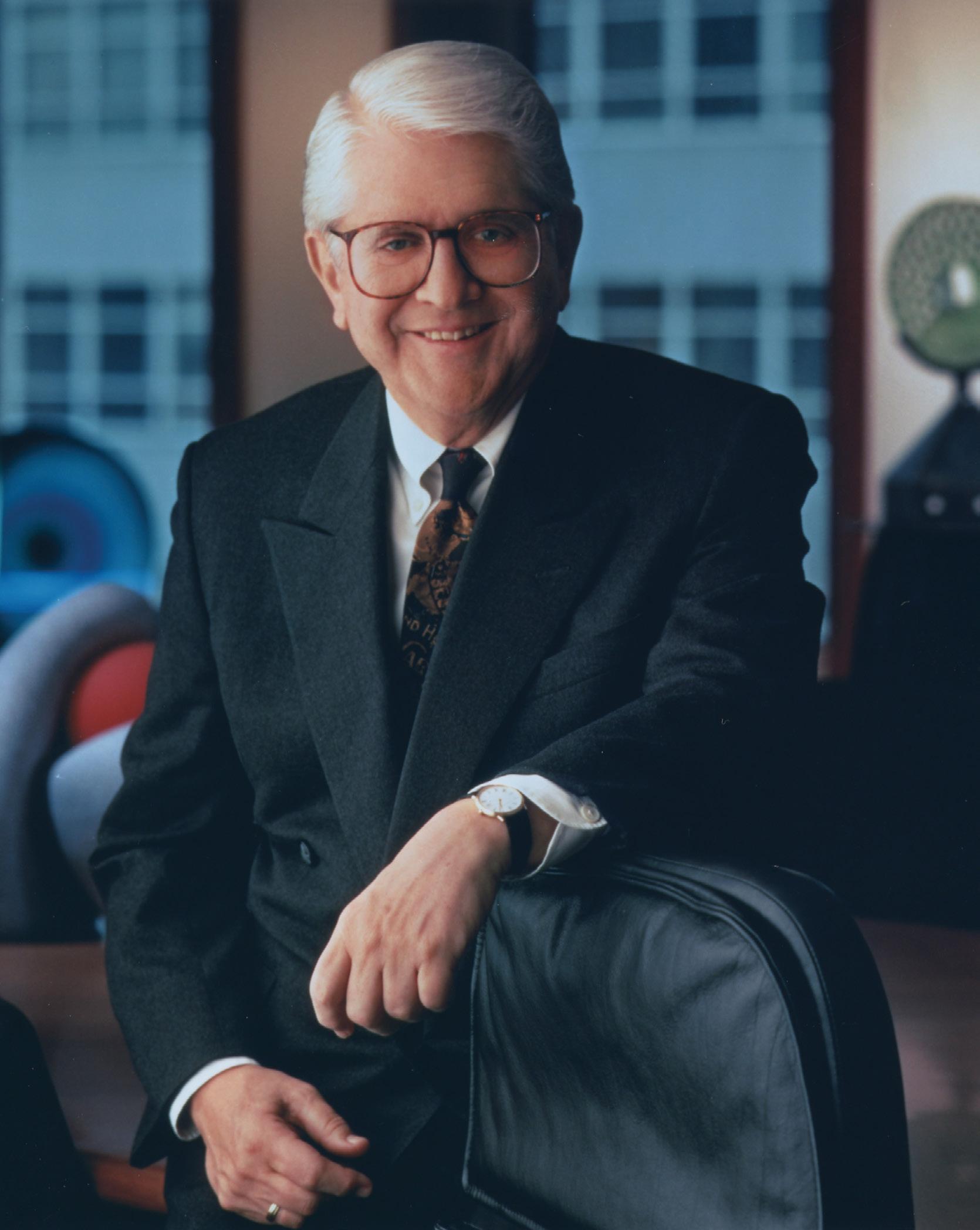
to ask themselves, “Did you make the right choice?”

Fashion Goes Global
EQUILIBRIUM

18
Equilibrium Volume 4
HAD THE OPPORTUNITY TO SPEAK WITH JEROME CHAZEN, who generously donated to the University of Wisconsin-Madison to make the Chazen Museum of Art possible. Chazen received his Bachelor’s of Arts in Economics at UW-Madison and his MBA at Columbia Business School. Spending the majority of his career in the fashion industry, he was one of the four founders of Liz Claiborne Inc. Under the global visioning of Chazen, Liz Claiborne became a world-wide powerhouse of the fashion industry. But as with any large company, it started small, and its success stemmed from its relationships and insights into the needs of customers.
Equilibrium Volume 4 What’s a College Degree
Interview by EQ Staff Written by Justin Bloesch
Worth?
“I knew that customer, I knew what they thought, what their problems were. As a retailer, I was very passionate about the business. I spent a lot of time researching in stores, talking to consumers, watching them, watching the trends, talking to other people - it was something I just did. On weekends, I would go visit stores to see what was going on in the fashion part of the store. The year before we founded Liz Claibourne, I saw a slight difference in the consumers . They were busy ladies, they seemed to be looking for something else they could wear beside a dress, and there was nowhere for them to go.”
It was the mid-1970’s, and women were joining the labor force in unprecedented numbers. Yet up until this point, a dress was the standard for every occasion. Be it formal, professional, or casual, department stores provided few other options for women. This is when Liz Claibourne entered the scene, and within 10 years, the company reached the list of Fortune 500 companies.
Fashion was far from being the obvious choice for Chazen in the beginning. Growing up in New York, Chazen found Madison appealing for its progressive traditions. After taking a broad set of classes, he was particularly intrigued by labor economics and the position of workers in Europe and the US. “In Europe, the big owners of capital own everything and have palaces, and the people who work for them have nothing. That’s why in Europe they have revolutions,” he says, quoting his favorite professor. “In the US, the owners have beautiful homes and they have Cadillacs, but the workers have Chevrolets!”
After leaving Madison, Chazen went on to get an MBA from the Columbia Business School in finance and accounting. “The theory was,” he said, “if worse comes to worst, I could become an accountant.” Fortunately this never came to pass, and he worked for a few years on Wall Street. At the same time, Chazen had a friend from UW whose family owned an apparel company in Milwaukee. Though hesitant right away, Chazen was convinced to join the company and begin his career in the apparel industry.
Fast-forward to 1979, when Chazen took his first trip to East Asia. By then, Chazen was already comfortable with foreign suppliers: his experience in apparel had already brought him to survey and purchase from the fashion industry in Europe. But it was Chazen’s trip to Hong Kong that sparked the new idea to begin production overseas. He knew this idea would not be welcomed immediately, as the apparel industry was entirely US based in the 70’s. He quotes Liz Claiborne, the designer herself, saying, “We can’t watch over our factories in New Jersey. And you want us to make goods 10,000 miles away? Never. Never!” A year from that day, 100% of the company’s production was overseas. “But if I had not had that overseas exposure,” he adds, “I think Liz would have been another Mom & Pop company.”
The company benefitted from overseas production for a while. “We were not only getting the goods for much lower cost, but we were getting a better product than we could in the US.” But it was not long until other companies, and other industries, followed suit. With greater competition from the electronics industry, the toy industry, and others, the apparel industry could no longer compete for workers. Liz Claiborne moved to other countries where labor was cheap, but that would also change. “They were making in a month what we would pay a normal employee in a day. But that’s changing as well, and prices
are going up. And that’s terrific.” Wages have risen so much, that many suppliers are beginning to return back to the US.
“I’m a globalist. I was always a globalist. My long term dream for the world is that we achieve global parity. That everyone in the world gets paid approximately the same amount for the work that they do.”
Though Chazen is a strong believer of thinking globally, he has not forgotten where he is from. He has done works of philanthropy for both of his almae matres, supporting the Chazen Museum of Art at UW-Madison and the Institute of International Business at the Columbia Business school. This was because his years at Wisconsin were of great personal significance to him. He says, “The friendships you make, the age you are at as you’re having those experiences, are quite different from graduate school. The friends that I made at UW continue to be my friends today.”
Today, the Chazen museum stands as one of the landmarks of the UW campus. Home to the second largest collection of art in Wisconsin, the museum is an incredible resource for UW-Madison students and the surrounding community. Perhaps those art history classes Chazen took at as undergraduate were worthwhile after all.
When asked if he had any advice for young, aspiring economics majors, Chazen had two pieces to offer. The first was for those with a future in business, of any sort. He says, “The best advice I can give anybody is to really know your consumer, whoever your consumer is. To know your consumer very well, to know their needs and desires and aspirations, will help you in the business you are doing.” But more importantly, he offers all students a guide for their careers in the future. Hoping to quote Confucius, he says, “If you love the job that you do, you will never work a day of your life, and I believe that.”
If you were to ask any UW-Madison student what defines both their campus and the city of Madison, nearly all would mention the surrounding lakes. From participating in Hoofers to grabbing drinks at the Memorial Union Terrace, the lakes are an integral part of student life and of the city’s character. Yet it is widely recognized that by late summer, the lakes around Madison become a less desirable amenity. Nutrient runoff from nearby farmland has lead to abnormal growth in weeds and algae, resulting in a smelly green scum covering the lakes. In fact, the four Yahara Lakes of Dane County – Mendota, Monona, Waubesa, and Kegonsa, were to be placed on the county’s list of “impaired waters.”
What makes cleaning the lakes difficult is that it is costly: if farmers were not allowed to use their current fertilizers, they would bear a substantial economic cost. But at the same time, both the strength of the lake ecosystem and quality of life in the city would be significantly improved if these fertilizers were no longer used. Public policy makers, in hoping to craft a policy that would be the best for everyone, must consider, “How much are clean lakes worth to you?” But economists, preferring hard
Incorporating Consumer Uncertainty in the Valuation of Non-Market Goods


numbers and dollar amounts, will ask you a different question, “How much are you willing to pay to have clean lakes?”

To answer this question, economists employ a tool called contingent valuation. For most goods, economists have an informed guess from market transactions about how much consumers value that good: the price. The analysis from such markets leads to the construction of “price-based revealed preference models,” a theoretical construct relating a good and its pricings. However, for non-traded goods, like environmental or public goods, there is no buying and selling that can be observed. This can leave economists with uncertainty about the valuations that consumers place on a good.
The most logical response to this problem of wanting to know how much people value a good, is to ask them. But this can be problematic, and what people say they would pay for a good is not always what they actually would pay. For this reason, economists use contingent valuation (CV) models.
This valuation technique, which is also known as a stated preference model, uses consumers’ utility functions and their given “willingness to pay” to measure the value of non-market goods and construct an economic price based on its findings. In contrast to price-based revealed preference models, CV models are organized by directly surveying respondents about their willingness to pay (WTP) for specific goods or services that lie contingent, or conditionally, on the hypothetical situation set forth by the analyst. After the surveyor success-
Written by Brody Kothe
Artwork by Taylor McGrath
fully obtains the individual’s WTP, the respondent is then asked about the certainty of their answer; this technique is referred to as “ex post mitigation.” From these values, models are formed to piece together the expected WTP that any individual will have towards a good.

Despite being a popularly adopted method by many economic researchers, many downsides and limitations arise when using the contingent valuation method. These critiques lie in the fact that CV models are based on claims of what individuals would pay versus what they would do in an actual payment scenario. In his senior thesis, “Incorporating Consumer Uncertainty in the Valuation of Non-Market Goods,” recent UW-Madison graduate Michael Klein addresses the common error in CV models of overestimation, also known as “hypothetical bias.” This bias arises when individuals facing hypothetical situations claim to pay more than they would in an actual payment scenario. It is such a regular occurrence to deal with hypothetical bias, that many studies commonly diminish the WTP estimates from the CV model.
In his thesis, Klein uses data from two experiments relating to private
21
Fashion Goes Global Equilibrium Volume 4
Research by Michael Klein
Willingness to Pay Equilibrium Volume 4
healthcare goods conducted by Bloomquist from the University of Kentucky. The experiments were designed to estimate an individual’s WTP for a health care related management program offered from their local pharmacy. One survey offered a diabetes management program, while the other survey offered an asthma management program. Each experiment divided the sample approximately in half and placed individuals into either a “hypothetical group” or “payment group.” This distinction allows for comparisons to be made between the CV model estimates for individuals who were asked what they would hypothetically pay versus individuals who actually had to pay. Each individual was then surveyed face-to-face to find the WTP estimate as well as the certainty of their response on a 1-10 scale.
Using this data, Klein estimates the expected WTP among each payment group for both experiments using the traditional CV modeling approach. Klein employs a logistical regression in order to restrict WTP estimates to a non-negative value. From the analysis of this regression, Klein is able to determine statistical significance at the 10% level and conclude that hypothetical bias was existent in each trial between the hypothetical and payment groups. This finding informs that, for certain prices, the hypothetical group is much more likely to purchase the management program than the payment group.
Klein claims that a possible reason for this bias is mainly derived from the fact that these models rely heavily on the three rigid central assumptions of neoclassical economics: people have rational preferences, individuals maximize utility, and consumers possess all full and relevant information. In other words, consumers react to payment situations by referencing their utility functions and acting consistently on them. From the study, Klein discovers that 40% of the individuals surveyed indicated a certainty value of less than 10. These findings indicate that a large percentage of the population is not completely certain of their preferences, implying that the neoclassical assumptions are contradicted. Since each person’s preferences are unclear to them, individuals can only provide a value based off their own probability that it will assume that value. This speculation leads to the overestimated values that are the hypothetical bias.

Unsatisfied with these findings, Klein aims to construct a new model that accounts for this consumer uncertainty. He transforms participants’ answers into a probability of purchase (POP) using a 0 to 10 scale. For example, if someone answers “yes, I will buy this prescription drug at $20” and chooses a certainty value of 10, this person is given a POP of 100%. If someone answers “yes” with a certainty value of 9, they have a probability of 95%. This continues so that if a participant answers “yes” with a confidence value of 0, Watson gives them a 50% probability of making the purchase.
The main benefit to employing this new data set is that it helps lead to a decrease of hypothetical bias. Because of the recoding, lower certainty values now have a smaller impact on the data. Klein shows that this is true by comparing the parameter estimates of the tradition CV model with those of the new POP CV model. He concludes that while his model significantly reduces the hypothetical bias of CV models, it still retains significant bias.
Despite finding an improved model, the struggle to rid experiments of hypothetical bias highlight the critical problems of a popular technique used by many economists. While there are many techniques economists can use to try and account for this hypothetical bias, it may unfortunately be the case that it is a permanent facet of the modeling. Because of this, many economists either stay away from the models or require a high burden of proof before their results be considered accurate. Regardless of one’s opinions on the value of CV models, Klein’s work clearly demonstrates the challenges of modeling human behavior.
Han vs Hui

An Analysis of Income Inequality between Han and Hui in Ningxia, China
Research by Zenan Wang
Written by Amy Wang
China is a remarkably diverse country. Besides the majority Han Chinese, 55 other ethnic groups are officially recognized by the Chinese government (PRC). Together, these groups number 105 million citizens but make up less than 10 percent of the Chinese population. To ease the tensions that
mous Region, home to approximately two million Hui people, Wang explored the composition of income inequality in one of China’s most restive regions.

Although physical conflicts between the Han and the Hui are not frequent, reli gious (as Hui is predominately Muslim)
through “settler-colonialism,” that is, theity ethnic Hui areas. Between 1949 and 2008, the proportion of Han in Xinjiang rose from 6.7 percent (220,000) to 40terns can be found in Tibet and Ningxia

arise from having large disparities in population and opportunity, the PRC has implemented many minority-oriented education and hiring policies. However the effectiveness of these policies is called into question in light of the recent ethnic conflicts over the western regions of Xingjiang and Tibet. The growing inequality in many aspects of lives gave way to eruptions of long-held tensions which inspired UW-Madison student Zenan Wang’s honor’s thesis. Focusing on the Ningxia Hui Autono-
cultural, and language differences present difficulties for not only the Hui but all other ethnic minorities. Extreme cases include the self-immolation of 125 Tibetans since 2009. And more recently on October 30, 2013, a SUV carrying a family of three Uyghurs crashed into the iconic Tiananmen Square, killing five people and injuring 40. Although Han Chinese play a vital role in the economic development of Western China, they are perceived by many as reinforcing inequality in the autonomous regions
Many
studies have shown that minorities’ quality of life has risen at a slower rate than that of Han since Reform and Opening. Han are viewed as cheating good jobs away at the expense of the minorities’ social mobility and earnings capacity, especially in the labor market. The frill of China’s economic reform that have created new jobs in the coastal regions failed to reach many minorities in the South and the West; at the same time, changes to the household
22 23 Han vs Hui Equilibrium Volume 4
Willingness to Pay Equilibrium Volume 4
registration system (Hukou) have installed further migration barriers. Scholars have noted that Han migrants to Xinjiang are still given priority over minorities in obtaining urban employment.

fied than Han about their lives. Wang observes from the literature that direct evidence of discrimination are found.
Maurer-Fazio (2010), for instance, conducted a job application experiment sending identical resumes with ran-

incomes from second or part-time jobs were deducted and observations with missing values were remedied with the generation of new variables. To provide a general sketch of the data, Wang provides descriptive statistics using a t-test.
This disparity triggered Zenan Wang to focus on the increasing income inequality because, according to him, “Although people’s welfare has dramatically improved during the past thirty years, income inequality is becoming increasingly prominent as well.” Concentrating on the Han-Hui discrepancy, Wang uses an urban survey data collected in the Ningxia Autonomous Region to extrapolate the possible wage discrimination conditioned on gender. Employing Neumark’s variation of the Oaxaca-Blinder method, a standard method for measuring outcome differences between groups, Wang’s paper confirms findings of Li & Deng which states that there is no measurable income gap between Han and Hui. However, Wang is the first to explore the model with gender groups in attempts to gain further understanding of Li & Deng’s finding.
After a qualitative analysis of the field, Wang observes previous studies that have undoubtedly shown the presence of ethnic wage discrimination using national data. Gustafson & Li (2003) have found that the income of minorities increased at a much lower rate compared to the Han’s during the seven year period which they studied, suggesting not only an existence of an income gap but an ever-widening one. Further evidence by Wei (2009) demonstrated that minorities, despite the rapid economic surge, in general were less satis-
domly assigned typical Han or typical minority names to firms. The result was a significantly higher callback rate for Han profiles than for minority profiles, proving the existence of discrimination in the labor market.
Intriguingly, results generated from regional data have proven inconclusive for the presence of discrimination. However, captivated by the significant statistical differences between the earnings of Hui females and Hui males from the Li & Deng (2009) study, Wang hypothesizes that, “It is arguable that the minority male and minority female are treated differently in the labor market.”
Citing one shortcoming of the previous studies as the failure to examine the male and female Han-Hui wage separately, Wang proceeds to account for gender by adding two terms, a male premium and a female penalty, into the original Oaxaca model. Deriving from the difference that exists between Hui female and Hui male earnings data, Wang was able to theorize that Hui women are subject to discrimination in the labor market under regional data, while Hui men are not.
Attempting to elucidate the findings of Li & Deng, it was natural for Wang to consider the same dataset. This survey data, collected in Ningxia in 2007, consist a total of 2,445 urban residents of which 1,067 are currently employed. Ridding possible confounding variables,
He finds that there are significant differences in the average wage between Han females and Hui females (t=0.12; P<0.005), but not between Han males and Hui males (t=-.05; P>.010).
While
descriptive statistics are useful, they are not enough to provide evidence of discrimination. Therefore, Wang uses regression analysis to control for observable characteristics, allowing him to see what share of wage difference is due to discrimination. Wang finds that while wage discrimination is present among the female group, it is not found for the male group. Examining the statics closely Wang sees that, although the overall t proved to be non-significant, the sub-categorical t in Hui male who received technical secondary school (t=-0.41; P<0.005) and who live in less developed areas (t=-0.07; P<0.010) are significant and carry negative signs, suggesting that Hui male high school and technical school graduates earn more than Han male, while Hui male living in less developed areas receive better pay than its Han counterparts. It is noteworthy, however, there was only one positive significant t present alluding that “Han has substantial advantages over Hui in the industry related to education, health, culture or scientific research” (t=0.26; P<0.005).
Analyzing Han-Hui wage discrimination within gender groups seems to
produce results closer to reality. Central to Wang’s discussion of wage discrimination is the decomposition and identification of the wage structure. By running Neumark’s (1988) variation on Oaxaca’s decomposition, Wang finds that 25 percent of the wage difference between Han and Hui female cannot be explained by character differences, and thus could be attributed to discrimination. The story is inconclusive for the male sample with a statistically insignificant but negative differential, potentially indicating that the average log wage of Hui is higher than that of the Han.
In addition to establishing the presence of discrimination, Wang finds it beneficial to investigate the channels of discrimination. He finds that Hui females suffer from discrimination in both a negative return to education and
a lower marriage premium compared to Han females. Hui females receive lower returns to education than Han females, and Wang supposes that this could be, “A consequence of employer’s assumption that Hui tend to receive low-quality education.” He proposes that the lower marriage premium paid to Hui females could be attributed to the fact that many traditionally stop working after marriage. Following this logic, Wang states that, “Assuming that Hui female workers are likely to quit, employers would be reluctant to pay these workers the wage they should pay.”
Thus, the well-being of Hui males masks the discrimination against Hui females in the labor force whose wages are burdened by a lower return to education and a marriage premium. Despite the decomposition, Wang advocates further investigations in his paper. Omitted
variables such as the quality of schooling could also have an effect in the wage disparities; that is, the complexity of the Chinese educational system needs to be addressed and improved to abridge the returns to education. Since discrimination in the labor force could also take forms of occupational barriers, a characteristics regression can better inform policy makers of its sources. Essential to evaluating China’s preferential policies and its potential impact on sharpening the ethnic divide, Wang’s findings shed light on the seemingly nonexistent wage discrimination between Han and Hui. After all, what the Chinese government and its people desire is “stability above all else,” and that “harmonious society” can only be achieved through levitating inequalities among its citizens.
24 25
Han vs Hui Han vs Hui Equilibrium Volume 4 Equilibrium Volume 4
Wang was able to theorize that Hui women are subject to discrimination in the labor market under regional data, while Hui men are not.
EQ: Why did you choose to study Economics as an undergraduate?

Goodrich: I chose to study economics because I wanted an education that gave me the tools to solve problems across a wide range of disciplines and issues while also gaining a better understanding of how the economy works. I knew I wanted to work in banking but chose to study economics over business and finance because I wanted to understand the bigger picture first, particularly how monetary and financial systems work on a macro scale.
Peter Goodrich
Peter Goodrich graduated from UW-Madison in 2011 with a double-major in Economics and History. He was an active member of the Economics Students Association as an undergrad and his passion for macroeconomics has led to a career at the Federal Reserve in Chicago.
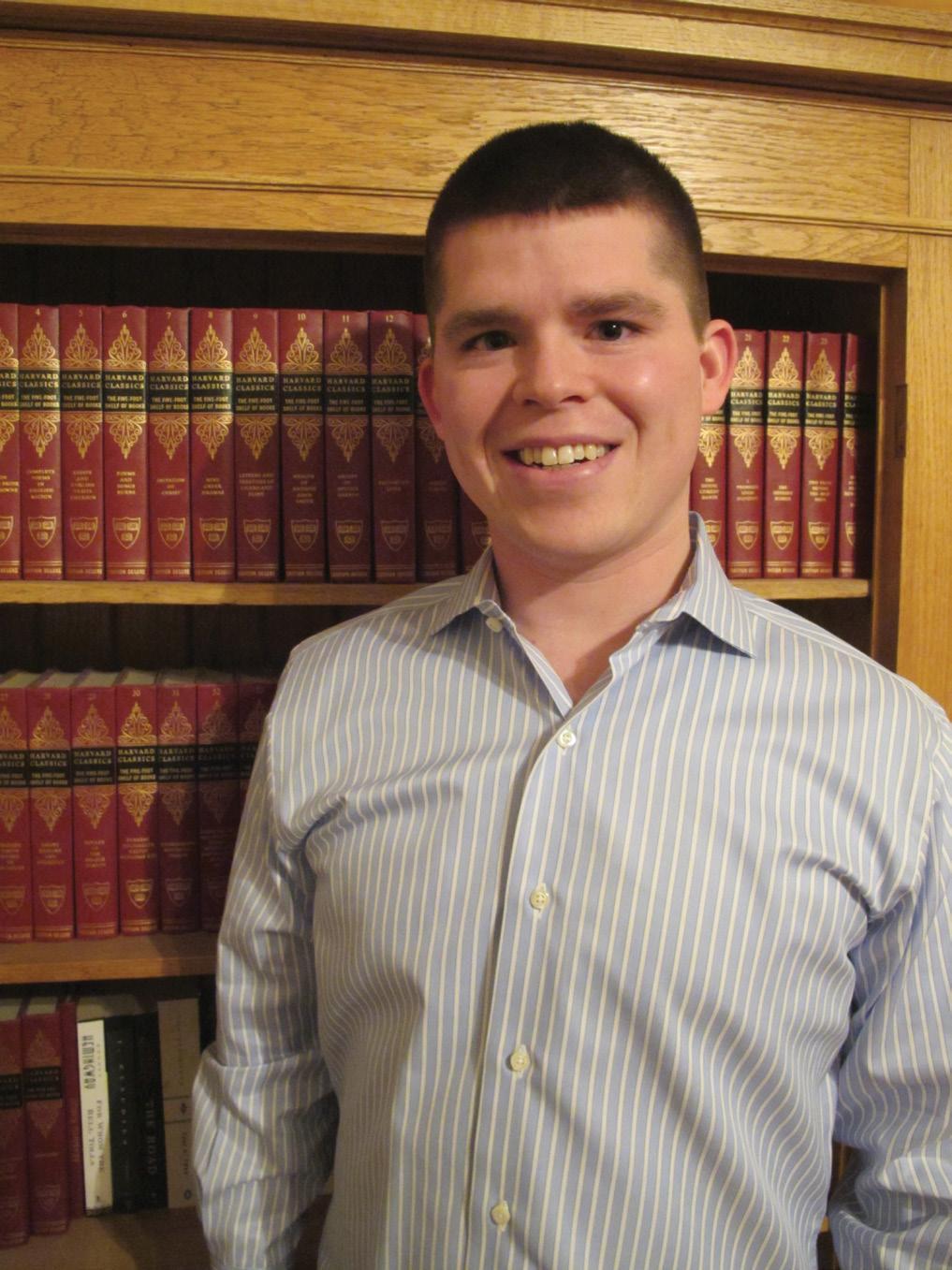
EQ: If you could re-live one experience that you had as student here, what would it be?
Goodrich: Rushing the field at Camp Randall after the Badgers, ranked #16 at the time, beat #1 ranked Ohio State during the 2010 season. This was easily one of the most memorable sporting events I had ever been to, and one of those times you feel lucky to be a Badger in Madison.
EQ: Was there one course or professor who had a particularly profound impact on you as a student?
Goodrich: I took Econ 330 – Money and Banking during the Fall of 2008 when the Financial Crisis was most turbulent. Taking this course as the financial and banking system was on the edge of collapse had a profound impact on me because we would come to class and talk about what was happening in the markets, and had to skip entire chapters in our textbooks because the Fed’s unconventional policies had changed standard economic theories. After reading the headlines about the financial crisis I immediately became interested in finding out more about what was happening and why, and was lucky to take Professor Menzie Chinn’s public policy seminar on monetary policy and financial regulation.
understand the environment within which banks operate, as macroeconomic conditions, especially the Fed and FOMC policy, drive a bank’s marginal revenue and marginal cost through interest rates.
EQ: Could you tell us more about your experience working at the Federal Reserve? What are some of the biggest challenges you have faced? What do you particularly enjoy about your position?


Goodrich: As an assistant examiner with the Federal Reserve, I participate on examinations of small community banks as well as larger financial institutions. Our goal on examinations is to assess the financial condition and risk management practices of banks and financial institutions. On any given exam, I could be reviewing a bank’s earnings, capital, the quality of its loans, or its sensitivity to changes in interest rates. One of the biggest challenges of my job is staying abreast of new bank regulations. With the passage of the Dodd-Frank Act, and new regulatory proposals from the Basel Committee on Banking Supervision, the regulatory environment is constantly changing, which means new rules and regulations that I have to read and understand to ensure banks are following them. I particularly enjoy the constant change in my job, as I typically review a different bank every two weeks and on each assignment I am reviewing something different. This change has been a great way to learn how banks are managed and I have been to many small towns across the Midwest that I don’t think I would have ever been to without this job.

EQ: Where do you see yourself in 5 years?
Goodrich: The Chicago Fed is a great place to work and I definitely see myself staying here for at least another 5 years. I am currently in a 3 year training program to become a Commissioned Examiner, once I finish this program towards the end of the year I plan to specialize in capital markets related activities of banks and large financial institutions. This specialty involves reviewing how banks manage their funding and liquidity, exposure to interest rates, as well as the use of derivatives.
EQ: What do you feel distinguishes UW-Madison’s Economics Department from others?
Goodrich: One of the biggest differences I’ve noticed as I’ve met colleagues from other universities is UW’s commitment to preparing students for their desired careers. The Economics Department Advisory Board has done tremendous work to help students prepare for professional careers, from establishing the Career Development Office to meeting students on campus and talking about their careers. I have yet to meet economics majors from other universities that had alumni networks with a similar level of involvement and commitment to undergraduates as UW Economics.
EQ: How has your background in economics prepared you for life after school?
Goodrich: I use the skills and tools I learned as an undergraduate at my job every day. The great benefit of microeconomics is its applicability to so many industries, especially banking.
On a given day I could be analyzing a bank’s earnings, capital levels, or assessing the quality of loans on its books. Understanding the fundamental rules of microeconomics, how firms maximize profits and make decisions based on marginal revenue and marginal costs, is essential to understand how banks operate. Understanding macroeconomics is also essential to
EQ: Do you have any suggestions for students hoping to pursue a similar career? Or maybe just UW-Madison undergrads in general?
Goodrich: UW-Madison does a great job preparing students for their careers but unfortunately there is a lot more students need to do to get a job in this economy. One of the best things
I did as an undergraduate was join ESA and attend the many recruiting and alumni events they held. These events are great ways to talk with professionals and alumni and figure out what kind of jobs are out there. Particularly if you want to work in finance, you have to read the news every day and understand what is driving markets, the latest earnings release for major companies, or politics in Washington.
Goodrich Peter
Equilibrium Volume 4 Equilibrium Volume 4
Peter
Goodrich
‘The opinions expressed in this interview are those of Peter Goodrich and do not necessarily reflect those of the Federal Reserve Bank of Chicago or the Federal Reserve System’
In just the past couple years, the Economics Student Association has:


Become the University’s Largest Student Organization Placed Students in Top Careers all Around the Country Hosted a Lecture by Morgan Stanley’s Chief Economist Brought a sitting Federal Reserve President to Campus Hosted an Election Debate with Top Political Economists Funded and Published Three Volumes of Equilibrium

28
To Join Equilibrium and Help Publish Volume 5 Contact: uwequilibrium@gmail.com





 Written by Sarah Hogue Artwork by Taylor McGrath
Written by Sarah Hogue Artwork by Taylor McGrath








 Research by Jonathon Schellenberg
Written by Neha Alluri
Research by Jonathon Schellenberg
Written by Neha Alluri




















